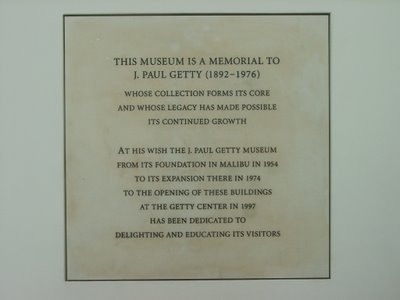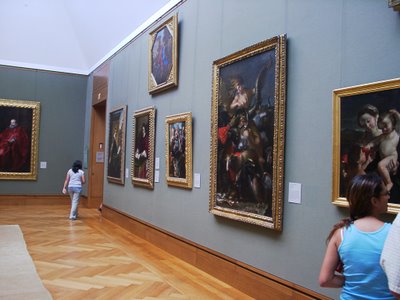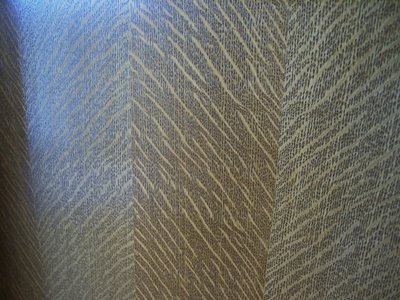Free Admission

The top picture shows gardens and architecture of the The Getty Center which is located on 750 acres in the foothills of the Santa Monica Mountains of Los Angeles County, California. It took Richard Meier, architect, and the J. Paul Getty Trust thirteen years and one billion dollars to construct this complex.
We parked our car in an underground parking deck at the bottom of the mountain. A mono-rail system carried all visitors to the hilltop to begin tours of this unbelievable place. There is no cost to visitors to enter the grounds, gardens, exhibit halls, and film presentations within this complex. (Oil money earned by J. Paul Getty and now in a $10 billion trust covers the cost) There are docents and volunteers in every room and at every turn to guide and explain everything one wants to know about the complex. Famous art from European countries dating back to the early eighteen hundreds is on display. The construction and design of this complex is difficult for me to comprehend.
One hundred ocean freighter voyages were needed to deliver the travertine stone from Italy for the building's facade. Romans used travertine from the same quarry to build the Coliseum, Trevi Fountain, and the colonnade of St. Peter's Basilica. There is no mortar between the 30" x 30" square travertine stone panels. Grid lines formed by the walls, floors, steps-whether stone, glass, or wood-are perfect straight lines. All dimensions are a multiple or factor of 30.
Crepe myrtle trees in the Central Garden are planted in straight alignment and kept the same diameter and height. Thirty-eight full-time gardeners are employed for upkeep of all the gardens.
The wood floors and door frames are quartersawn oak of perfection and pattern that seem impossible. See pictures below to understand what I mean about the wood.
I met retired teachers on the architectural part of the tour who had returned for the fifth time to visit this museum. I understand now why repeated visits are needed to begin to absorb and appreciate the spendor of the architecture and history depicted in the art works.
Return here on Sunday, August 6 for an update.
Have a good day!



Labels: Seattle


0 Comments:
Post a Comment
<< Home